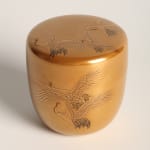Tsuboi Hidenori
Flying Cranes Tea Caddy, 1980s
Maki-e gold and red lacquer on wood
Size 3 x 3 x 3 in. (7.5 x 7.3 x 7.3 cm)
T-4997
Further images
-
(View a larger image of thumbnail 1
)

-
(View a larger image of thumbnail 2
)

-
(View a larger image of thumbnail 3
)

-
(View a larger image of thumbnail 4
)

-
(View a larger image of thumbnail 5
)

-
(View a larger image of thumbnail 6
)

-
(View a larger image of thumbnail 7
)

-
(View a larger image of thumbnail 8
)

-
(View a larger image of thumbnail 9
)

-
(View a larger image of thumbnail 10
)

-
(View a larger image of thumbnail 11
)

-
(View a larger image of thumbnail 12
)

Comes with its original fitted paulownia-wood tomobako storage box inscribed Gunzuru maki-e natsume (Tea Caddy with Maki-e Design of cranes) and signed and sealed Sekiho. The accompanying tomogire cotton cloth...
Comes with its original fitted paulownia-wood tomobako storage box inscribed Gunzuru maki-e natsume (Tea Caddy with Maki-e Design of cranes) and signed and sealed Sekiho. The accompanying tomogire cotton cloth is also signed and sealed Sekiho.
Accompanying printed biography: Tsuboi Hidenori 坪井英憲. Born 1954; apprenticed with Yamamoto Kōzaburō in 1977; became independent in 1983; lives in Wajima; art name: Sekiho 夕帆. He moved to his birthplace of Sakai in the wake of the January 1, 2024 Wajima earthquake
Accompanying printed biography: Tsuboi Hidenori 坪井英憲. Born 1954; apprenticed with Yamamoto Kōzaburō in 1977; became independent in 1983; lives in Wajima; art name: Sekiho 夕帆. He moved to his birthplace of Sakai in the wake of the January 1, 2024 Wajima earthquake











